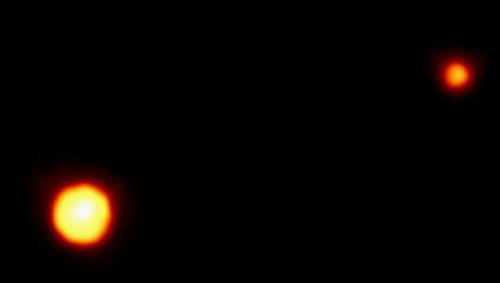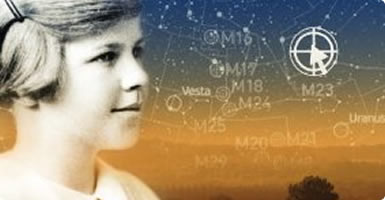
This NASA handout photo shows the clearest view yet of the distant Pluto and its moon, Charon, as revealed by NASA’s Hubble Space Telescope (HST). The image was taken by the European Space Agency’s Faint Object Camera on 21 February, 1994
Venetia Phair, who was 11 years old when she suggested Pluto as the name of the newly discovered planet, has died, her family said. She was 90.
Ms. Phair died at home in the London suburb of Epsom on April 30, the family said. The cause of death was not disclosed.
The family said a funeral would be held Friday.
Born Venetia Burney, she suggested the name to her grandfather at breakfast in 1930.
“My grandfather, as usual, opened the paper, the Times, and in it he read that a new planet had been discovered. He wondered what it should be called. We all wondered,” she recalled in a short film, Naming Pluto, released earlier this year.
“And then I said, ‘Why not call it Pluto?’ And the whole thing stemmed from that.”
__________

This is the story of Venetia Phair, who as an 11-year-old Oxford schoolgirl in 1930, came up with the suggestion for the name of the newly discovered Planet X over a family breakfast, making her inspiration to name it Pluto a unique contribution to scientific history. 77 years later, Venetia is yet to see Pluto through a telescope and in the recent light of its demotion in 2006, she’s invited by Sir Patrick Moore to view the planet she named through his telescope.
The sighting proves unsuccessful and Venetia waits a year before a second opportunity is extended, this time by the Science Observatory in Herstmonceux. Coincidentally the viewing happens on the eve of her 89th birthday. Pluto’s demotion has divided the scientific community and undone 70 years of learning for millions of children around the world. Before scientific technology takes us to the next chapter of planetary discovery and introduces further wonders to us, Naming Pluto looks back at the extraordinary way a young girl came to name a planet and witnesses her long awaited reunion with planet she named.
__________
Her grandfather was Falconer Madan, the retired librarian of the Bodleian Library at Oxford University. He relayed the suggestion to his friend Herbert Turner, professor of astronomy at Oxford, who on that day was at a meeting of the Royal Astronomical Society, where possible names for the planet were being discussed.
Mr. Turner then passed the suggestion to Clyde Tombaugh, who made the discovery, at the Lowell Observatory in Arizona.
When the name was publicly announced May 1, 1930, Ms. Phair said her grandfather rewarded her with a five-pound note.
“This (amount) was unheard of then. As a grandfather, he liked to have an excuse for generosity,” she told the British Broadcasting Corp. in 2006.
She was fascinated by astronomy, and recalled playing a game at school using clay lumps to mark out the relative positions of the planets. She was also a keen student of mythology, and knew about Pluto, the Roman name for the Greek god of the underworld, Hades.
“There were practically no names left from classical mythology. Whether I thought about the dark and gloomy Hades, I’m not sure,” she told the BBC.
She tartly rejected any suggestion that the planet was named for the Disney dog, instead of the other way around. “It has now been satisfactorily proven that the dog was named after the planet, rather than the other way ‘round. So, one is vindicated,” she said.
The International Astronomical Union downgraded Pluto in 2006 to a dwarf planet — based on the observation that it was a large chunk in the Kuiper Belt of solar debris.
Ms. Phair said she was indifferent about Pluto’s change of status, “though I suppose I would prefer it to remain a planet.”
An asteroid discovered in 1987 was named in her honour: 6235 Burney.
She studied mathematics at Cambridge University, and taught economics and math until retiring in the 1980s.
Her husband Maxwell Phair died in 2006. She is survived by their son, Patrick.
__________
Full article and photo (1): http://www.theglobeandmail.com/servlet/story/RTGAM.20090507.wpluto0507/BNStory/Science/home
Inset and photo (2): http://www.sci-fi-london.com/festival/2009/programme/short/naming-pluto.php
__________
See also:
Venetia Phair Dies at 90; as a Girl, She Named Pluto
Frozen and lonely, Planet X circled the far reaches of the solar system awaiting discovery and a name. It got one thanks to an 11-year-old British girl named Venetia Burney, an enthusiast of the planets and classical myth.

Venetia, in 1930
On March 14, 1930, the day newspapers reported that the long-suspected “trans-Neptunian body” had been photographed for the first time, she proposed to her well-connected grandfather that it be named Pluto, after the Roman god of the underworld.
And so it was.
Venetia Phair, as she became by marriage, died April 30 in her home in Banstead, in the county of Surrey, England. She was 90. The death was confirmed by her son, Patrick.
Venetia, on the fateful day that Pluto popped into her head, was having breakfast with her mother and her grandfather, Falconer Madan, retired librarian of the Bodleian Library at Oxford. He had exciting news to tell. Scientists at the Lowell Observatory in Flagstaff, Ariz., had just photographed a planet lying beyond Neptune. Its existence had been postulated since the late 19th century, and astronomers working under Percival Lowell, the observatory’s founder, had been chasing it photographically since 1906. Now theory had become fact.
“He wondered what it should be called,” Mrs. Phair recalled in the documentary film, “Naming Pluto,” released last month. “We all wondered, and then I said, ‘Why not call it Pluto?’ And the whole thing stemmed from that.”
Mr. Madan passed the idea along to his friend Herbert Hall Turner, professor of astronomy at Oxford. Pluto, he suggested in a letter, was an excellent name for “the big obscure new baby.”
Mr. Turner, as it happened, was in London for a meeting of the Royal Astronomical Society, where word of the new planet had members buzzing, and proposals for a name flew fast and furious. “I think PLUTO excellent!!” he wrote to Mr. Madan on his return. “We did not manage to think of anything so good at the RAS yesterday. The only at all meritorious suggestion was Kronos, but that won’t do alongside Saturn.” (Kronos is the Greek equivalent of Saturn.)
Mr. Turner immediately sent a telegram to Flagstaff: “Naming new planet, please consider PLUTO, suggested by small girl Venetia Burney for dark and gloomy planet.”
Unbeknownst to Venetia, a spirited battle ensued, with suggestions flying thick and fast. Minerva looked like the front runner, until it was pointed out that the name already belonged to an asteroid. Other candidates included Zeus, Atlas and Persephone. The Austrian engineer and cosmologist Hans Hörbiger proposed the inscrutable and unpronounceable Onehtn, meaning “first trans-Neptune.”
Capt. Charles E. Freeman, the superintendent of the Naval Observatory in Washington, regarded Pluto as a long shot. “Pluto is the prototype of Satan in many minds, and drops out for that reason, perhaps,” he said.
In the end, scientists at the Lowell Observatory voted unanimously for Pluto, partly because its first two letters could be interpreted as an homage to Percival Lowell, and on May 24 the new planet received its official name.
Mr. Madan gave his granddaughter a five-pound note, and the family added yet another feather to its cap: in 1877, Mr. Madan’s brother Henry, a housemaster at Eton, had successfully proposed that the two dwarf moons of Mars be named Phobos and Deimos, two attendants of the Roman war god, whose names mean fear and terror.
“Pluto is an excellent name, for two reasons,” Neil deGrasse Tyson, the director of the Hayden Planetarium and author of “The Pluto Files: The Rise and Fall of America’s Favorite Planet,” said in a telephone interview. “First, it’s a Roman god, as are the rest of the large objects in the solar system, so it conforms to the rules of the time, and second, Pluto is the god of the underworld, a distant place you don’t want to go to. Who could not love the name?”
Venetia Katherine Burney was born in Oxford, where her father, the Rev. Charles Fox Burney, was a professor of scriptural interpretation. He died when Venetia was 6, and she and her mother went to live with Mr. Madan.
Venetia developed an interest in astronomy after playing a game with other children in which lumps of clay, standing for the planets, were placed on a lawn in their positions relative to the sun.
She attended Downe House, a boarding school in Berkshire, and, after studying mathematics at Newnham College, Cambridge, became a chartered accountant. She later taught economics and math at two girls’ schools in southwest London. In 1947 she married Maxwell Phair, a classicist, who became housemaster and head of English at Epsom College. She is survived by her son, of Cheltenham.
Mrs. Phair tended to play down her stroke of genius. She came up with Pluto, she said, simply because it was one of the few important Roman gods still available for planetary duty. “Whether I thought about a dark, gloomy Hades, I’m not sure,” she told the BBC in 2006.
Regardless, Pluto was an instant success. Walt Disney used it for Mickey Mouse’s dog, and it provided the name for Element 94 in the Periodic Table, plutonium, which was first identified in 1941. In 1987 the asteroid 6235 Burney was named in Mrs. Phair’s honor, as was a dust-measuring instrument on board New Horizons, the NASA spacecraft that took off for Pluto in 2006.
Mrs. Phair took it in stride when the International Astronomical Union decreed that Pluto was not a planet at all. It was a dwarf planet, and not even the largest one, a lump of rock and ice orbiting in a ring of icy debris known as the Kuiper Belt.
Some face was saved last year when the union announced the coining of the term “plutoid” to designate a dwarf planet beyond the orbit of Neptune. More vexing to Mrs. Phair was the persistent notion that she had taken the name from the Disney character. “It has now been satisfactorily proven that the dog was named after the planet, rather than the other way around,” she told the BBC. “So, one is vindicated.”
Alan M. MacRobert, a senior editor at Sky and Telescope, foresees sweeter vindication ahead. “In the year 4,000 A.D., when Pluto is hollowed out and millions of people are living inside,” he said, “the name of Venetia Burney may be the only thing that Great Britain is remembered for.”
__________
Full article and photo: http://www.nytimes.com/2009/05/11/world/europe/11phair.html?hpw
